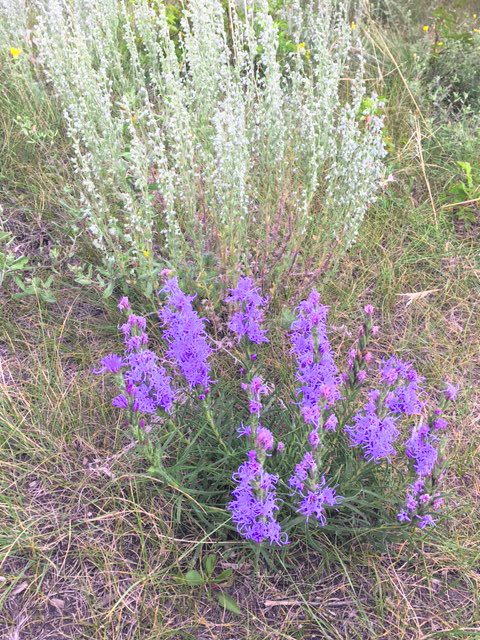by Jill Thomson
When we are introducing new plants to our gardens, growing conditions should be matched to plant preferences – soil type, drainage, hours of direct sunlight, amount of shade, proximity to other plants, shelter from wind, etc. Recently, I have realized that observing plants in their native habitat helps with choosing their placement in my garden. One of my favourite and frequent places to walk our dogs is at Chief Whitecap Park (CWP), south of Saskatoon. The park has a wide range of habitats, particularly if you walk through the undisturbed native prairie at the south end and then into the transition zone between the river bank and the river woodland, where prairie shrubs are found. You can scramble down the steep bank and walk along the river’s edge, then walk through the woodland in the valley before taking a path back up to the grassland. There are many beautiful native plants that bloom from the end of the first snow in the spring to the frosts and snow of fall. I have made notes and taken photos of the flowers that bloom sequentially throughout the season.
Many people walk through the park to see the prairie crocus (Anemone patens var. multifida) that flowers in the undisturbed prairie at the south end, even when we have a late snowfall. This plant needs to grow in undisturbed soil that is not shaded, and does not usually do well in a traditional garden. However, I have included its Latin name, because the native plant has been crossed with a European species (Anemone pulsatilla) and their hybrid offspring are a great addition to the garden.
Another favourite early flowering prairie plant is the three-flowered avens (Geum triflorum) and it is this plant that clued me in to taking notice of where plants like to grow. I had planted a specimen at the edge of my north-facing front yard, close to the sidewalk. It grew well for about 5 years but gradually died out as the rest of the garden grew taller and even the edge became shaded. Now I enjoy seeing it flourish in the open, sunny areas of the prairie area.
Liatris and Penstemon species are both showy, flowering plants that need to grow in full sun, and both can be seen flowering at CWP in the open grassy areas in mid-summer.
There are several plants that can do well in most conditions, and the wild rose (Rosa species) is an excellent example. Short stemmed plants are found in the sunny locations, with flowers varying from white through various shades of pink.
When growing in shaded areas, including the edges of the woodland and the denser underbrush in the river valley, the stems grow longer, reaching up in the canopy, and the flowers tend to be a darker, more vivid pink.
These may be different species, found in the differing habitats (e.g., prickly rose [Rosa acicularis ssp. sayi] in prairie habitats and Wood’s rose [Rosa woodsii var. woodsii] in treed habitats).
This type of rose can flourish under similar conditions in the garden, mine has grown well at the edge of my overgrown front yard for at least 25 years.
Honeysuckle (Lonicera species), fleabanes (Erigeron species) and lilies (Lilium species), are all plants that are usually found at the edge of wooded areas along the river bank. Relatives of these species will also do well in the semi-shaded areas of your garden.
In the woodland area, on the banks and along the river valley, you can find plants that might do well in shaded areas of your garden, but remember to see what moisture conditions they prefer.
Two-leaved Solomon’s seal (Maianthemum canadense), bunchberry (Cornus canadensis) and wild sarsaparilla (Aralia nudicaulis) are all common understory plants. There is also a small patch of pink wintergreen (Pyrola asarifolia) I have seen beside one of the paths and I hope to buy some plants to try in my garden in 2021.
I have only mentioned a few of the many flowering plants you will see when walking in this park, and other native habitats.
An excellent reference book for identifying native plants that might do well in your garden is “Native plants for the short season yard” by Lyndon Penner.
Please remember that you should not dig up native plants from natural areas for two reasons. First, transplants may perform poorly and die within a short period as garden conditions are so different from where they were recently growing.
Second, you are creating an area of disturbance that will allow weeds to get a foothold. Rather, buy from reputable garden centres specializing in native plants that have grown plants from seed collected in a sustainable manner.
Jill Thomson is a plant disease specialist (retired) who enjoys walking her dogs at Chief Whitecap Park.
This column is provided courtesy of the Saskatchewan Perennial Society (SPS; saskperennial@hotmail.com). Check our website saskperennial.ca) or Facebook page (facebook.com/saskperennial). All Saskatchewan Perennial Society events are on hold until further notice.
-0.4 C
Prince Albert
Friday, April 19, 2024


